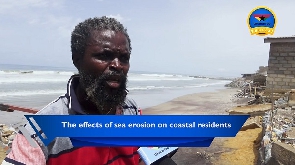Sea level rise, a consequential global phenomenon linked to climate change, is inflicting significant harm on the coastal communities of Ghana.
The adverse effects include heightened coastal erosion, resulting in the loss of livelihoods, settlements, and property for numerous individuals.
Residents surrounding Panbros, Glefe and Gbegbeyise communities along the Dansoman Coastline are among the many experiencing the harsh effects of sea erosion caused by climate change.
GhanaWeb’s Elliot Nuertey's interactions with some residents mentioned in the areas indicated that, over 100 homes have been destroyed, schools, churches and, six hotel and beach resorts had to close down due to sea erosion.
Nii Commey, a former professional footballer and the owner of the Overmas 1 Beach resort, is one of the residents, whose business has suffered.
He disclosed to GhanaWeb how he spent over GHS 600,000 on relocating and renovating his resort due to sea erosion caused by climate change.
“I have spent GHS600,000 on this resort. It even exceeds that amount. I bought stones. I brought excavators, pill loaders ,I have bought lots of things, I brought lots of machine to help salvage the situation. I have videos there,” Nii Commey lamented.
He added, “about five kilometres away used to be a sitting lounge and play ground for visitors who came here. They played football and danced to music, but today the sea has taken over.”
Nii Commey used to play for Mighty Jet, Gamba All Blacks and another Russian team.
His case isn’t different from Reuben Akakpo, one of the residents who are in constant fear for their lives and property, after relocating three times, Reuben Akakpo has been rendered homeless by the sea.
“This used to be my home (pointing to the foundation of a collapsed building), and that also was someone’s house too. The water has broken it all down. The sea conquer everything. Now just a lane of houses separate the sea from the main road right behind us,” Reuben Akakpo explained the dire effects of sea erosion on coastal dwellers along the Dansoman coastline.
This report is produced in fulfilment of the UNESCO & CIJ London Climate Change in News Media project facilitated by the Centre for Journalism Innovation and Development.
Watch the interview below:
General News of Sunday, 9 July 2023
Source: www.ghanaweb.com

















